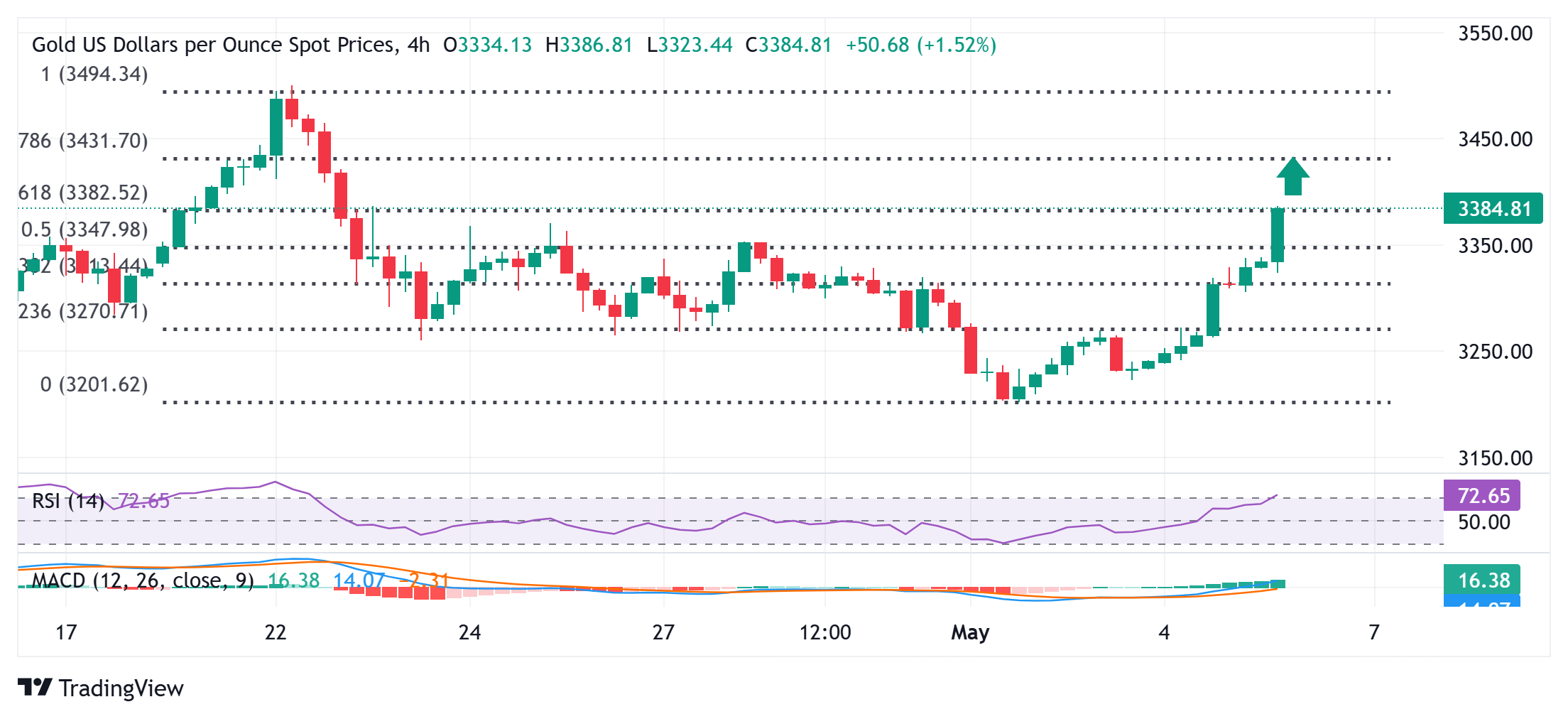
- Gold price continues to attract safe-haven flows amid rising geopolitical tensions.
- Subdued USD demand also benefits the commodity and contributes to the move up.
- Bulls, however, seem reluctant ahead of the key FOMC meeting starting on Tuesday.
Gold price (XAU/USD) sticks to positive bias for the second consecutive day on Tuesday, though it has retreated slightly from a nearly two-week high touched during the Asian session. Despite signs of easing US-China trade tensions, US President Donald Trump’s erratic trade policies keep investors on edge. Apart from this, persistent geopolitical risks stemming from the Russia-Ukraine war and conflicts in the Middle East drive some safe-haven flows toward the precious metal.
Meanwhile, the US Dollar (USD) continues with its struggle to attract any meaningful buyers in the wake of the heightened economic uncertainty on the back of Trump’s tariffs. This turns out to be another factor lending some support to the Gold price. Traders, however, refrain from placing aggressive bullish bets around the XAU/USD pair ahead of the crucial FOMC policy meeting starting this Tuesday. This, in turn, warrants caution before positioning for any further appreciating move.
Daily Digest Market Movers: Gold price remains well supported by trade uncertainties and geopolitical risks
- Speaking to reporters aboard Air Force One on Sunday, US President Donald Trump hinted at possible trade agreements with certain countries as early as this week, though he did not name any specific countries. Trump had signaled earlier that he is open to lowering massive tariffs imposed on China.
- Meanwhile, China’s Commerce Ministry said last Friday that it was evaluating the possibility of trade talks with the US. This, in turn, adds to the optimism over a possible easing of the tit-for-tat tariff war between the world’s two largest economies and remains supportive of a generally positive risk tone.
- The Institute for Supply Management (ISM) survey showed on Monday that the growth in the US services sector picked up in April. In fact, the ISM Services PMI rose to 51.6 compared to 50.8 in March and 50.6 estimated. This comes on top of Friday’s upbeat US jobs data and eases fears of a US recession.
- This assists the US Dollar to gain some positive traction following a two-day losing streak. The Gold price, however, continues to attract safe-haven flows amid uncertainty over Trump’s erratic trade policies and rising geopolitical risks. Trump on Sunday announced a 100% tariff on movies produced overseas.
- On the geopolitical front, Russian officials said that Ukraine launched drones at Moscow for the second night in a row, forcing the closure of the capital’s three major airports. Moreover, Ukrainian forces were trying to advance in Kursk and attacked a power substation in Russia’s western Kursk region.
- Furthermore, Israel, reportedly in coordination with the US, launched airstrikes on Yemen’s Hodeidah port in response to Houthi rebel’s ballistic missile attack that hit Ben Gurion International Airport on Sunday. This, in turn, provides an additional boost to the commodity on Tuesday.
- Traders now look forward to the highly-anticipated two-day FOMC meeting starting this Tuesday amid reduced bets for a rate cut in June. Hence, the accompanying policy statement and Federal Reserve Chair Jerome Powell’s comments on Wednesday will be scrutinized for cues about the rate-cut path.
Gold price bulls might now wait for a move beyond 61.8% Fibo. hurdle before positioning for any further gains

From a technical perspective, the strong intraday move higher lifts the Gold price beyond the $3,350 hurdle, which coincided with the 50% Fibonacci retracement level of the recent pullback from the all-time peak. This, along with positive oscillators on the daily chart, suggests that the path of least resistance for the commodity remains to the upside. Some follow-through buying beyond the 61.8% Fibo. level, around the $3,385 region, will reaffirm the positive bias and lift the XAU/USD beyond the $3,400 mark, towards the next relevant barrier near the $3,425 zone. The subsequent move up should allow bulls to make a fresh attempt to conquer the $3,500 psychological mark.
On the flip side, the $3,350 area now seems to protect the immediate downside ahead of the daily low, around the $3,325 zone. This is followed by the $3,300 mark, which if broken decisively might prompt some technical selling and drag the Gold price to the $3,275-3,270 intermediate support en route to the $3,245-3,244 region. A convincing break below the latter could make the XAU/USD vulnerable to accelerate the slide back towards challenging the $3,200 mark, or over a two-week low touched last Thursday.
Tariffs FAQs
Tariffs are customs duties levied on certain merchandise imports or a category of products. Tariffs are designed to help local producers and manufacturers be more competitive in the market by providing a price advantage over similar goods that can be imported. Tariffs are widely used as tools of protectionism, along with trade barriers and import quotas.
Although tariffs and taxes both generate government revenue to fund public goods and services, they have several distinctions. Tariffs are prepaid at the port of entry, while taxes are paid at the time of purchase. Taxes are imposed on individual taxpayers and businesses, while tariffs are paid by importers.
There are two schools of thought among economists regarding the usage of tariffs. While some argue that tariffs are necessary to protect domestic industries and address trade imbalances, others see them as a harmful tool that could potentially drive prices higher over the long term and lead to a damaging trade war by encouraging tit-for-tat tariffs.
During the run-up to the presidential election in November 2024, Donald Trump made it clear that he intends to use tariffs to support the US economy and American producers. In 2024, Mexico, China and Canada accounted for 42% of total US imports. In this period, Mexico stood out as the top exporter with $466.6 billion, according to the US Census Bureau. Hence, Trump wants to focus on these three nations when imposing tariffs. He also plans to use the revenue generated through tariffs to lower personal income taxes.
Information on these pages contains forward-looking statements that involve risks and uncertainties. Markets and instruments profiled on this page are for informational purposes only and should not in any way come across as a recommendation to buy or sell in these assets. You should do your own thorough research before making any investment decisions. FXStreet does not in any way guarantee that this information is free from mistakes, errors, or material misstatements. It also does not guarantee that this information is of a timely nature. Investing in Open Markets involves a great deal of risk, including the loss of all or a portion of your investment, as well as emotional distress. All risks, losses and costs associated with investing, including total loss of principal, are your responsibility. The views and opinions expressed in this article are those of the authors and do not necessarily reflect the official policy or position of FXStreet nor its advertisers. The author will not be held responsible for information that is found at the end of links posted on this page.
If not otherwise explicitly mentioned in the body of the article, at the time of writing, the author has no position in any stock mentioned in this article and no business relationship with any company mentioned. The author has not received compensation for writing this article, other than from FXStreet.
FXStreet and the author do not provide personalized recommendations. The author makes no representations as to the accuracy, completeness, or suitability of this information. FXStreet and the author will not be liable for any errors, omissions or any losses, injuries or damages arising from this information and its display or use. Errors and omissions excepted.
The author and FXStreet are not registered investment advisors and nothing in this article is intended to be investment advice.